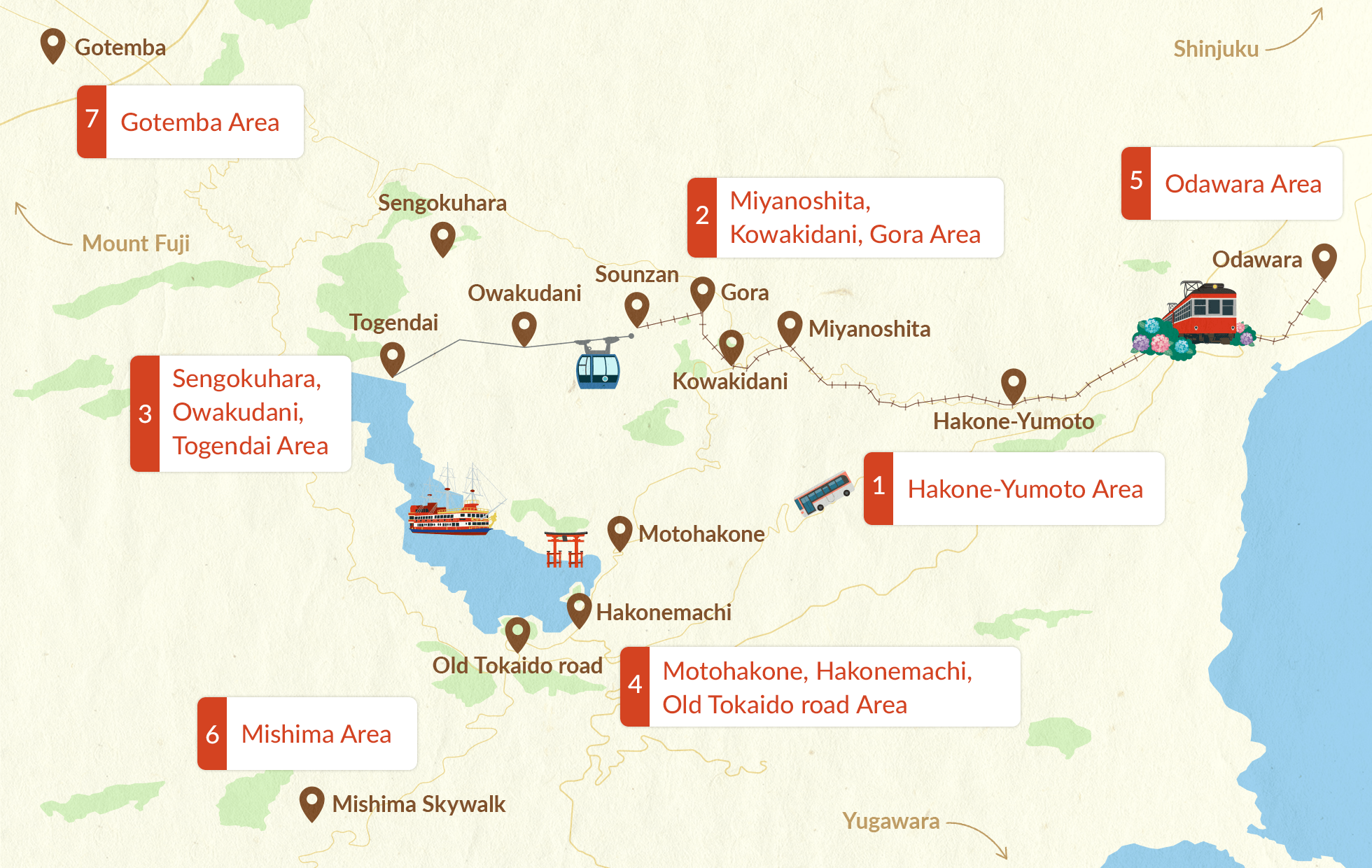Life Tips & Miscellaneous Travel and History Zen Philosophy and History Art and Sport Navigation of this blog
Geography of Hakone
Hakone is a region formed around Mount Hakone on the border of Kanagawa and Shizuoka prefectures, a beautiful mountainous area that has become a famous hot spring, nature and historical tourist destination.

At the heart of Hakone, Mount Hakone is an active volcano that is still active today, and as a result of volcanic activity that is believed to have started around 70 000 years ago, the volcanic area as we know it today was formed, with some areas, such as Owakudani, emitting sulphur-containing steam.

Lake Ashi, in the centre of Mount Hakone, is a caldera lake formed by the volcanic activity of Mount Hakone, and is surrounded by mountains, making it a particularly beautiful place to enjoy the scenery from the lakeside.

Hakone, and the marshlands and meadows to the south of Mt Hakone make Sengokuhara a famous tourist attraction in autumn, with its fields of sooty pampas grass.

Hakone’s geographical features are an important factor influencing not only its natural beauty and attractiveness as a hot spring resort, but also its historical and cultural aspects.
History of Hakone
<Manmaki Shonin and Hakone Shrine>
The history of Hakone begins with mountain worship, as described in ‘The History of Mount Fuji and the Mountain Climbing Race’. Mangan Shonin, the Heian-period priest who founded Hakone Shrine on the shores of Lake Ashi, chose Mount Hakone as a place to practise asceticism and, based on the idea of Shintoism and Buddhism, worshipped Hakone Gongen, who was later deeply involved in the construction of Hakone Shrine.

As described in ‘Kannushi Tsuki, Kannuri Tsuki and the Japanese Gods’, the Japanese gods were the mountains and the sea themselves, and the mountains of Hakone were the place where the gods dwelled.
<Minamoto no Yoritomo and Hakone in the Warring States Period>
As described in ‘Kaido yuku – Miura Peninsula Ki’, Minamoto no Yoritomo raised an army in 1180, lost his first battle to the Taira clan, and fled to Hakone Gongen, but later regained power and eventually destroyed the Heike clan and established the Kamakura Shogunate. The Yusaka Road, which ran from Hakone-Yumoto to Hakone-Toge and Mishima, was built so that travellers other than ascetic monks could also pass through Hakone.
During the Warring States period, Hakone came to be recognised as a strategic point, and became an area contested by the famous military commanders of the time, such as Takeda Shingen, Oda Nobunaga and Toyotomi Hideyoshi. Under these circumstances, the Hojo clan, which was based in Hakone, built a strong defence network against them, and Hakone also became popular as a hot spring resort, with the Sokokura Onsen in the vicinity of the current Fujiya Hotel becoming a therapeutic bath for the Hojo clan and an encampment site for Hideyoshi Toyotomi during his Odawara offensive.

Due to the diversity of the hot springs in Hakone, they are likened to a department store with one floor underground and four floors above ground. In order of altitude, the fourth floor (Ashinoyu, Ashinoko and Sengokuhara) is an ‘acid sulphate spring’, the third floor (Gora and Miyagino) is a ‘bicarbonate sulphate spring’, the second floor (Miyanoshita, Kowakudani and Ohiadai) is a ‘chloride spring’ and the first and ground floors (Hakone-Yumoto, Tonosawa and Hatajuku) are ‘mixed chloride-bicarbonate sulphate springs’.

<Hakone in the Edo period>
In the Edo period (1603-1868), it was necessary to cross the Hakone Mountains when proceeding along the Tokaido Highway, the main artery of transport, and a barrier was established at Hakone. Hakone, which was located at a good distance from Edo, also became a place where Edo townspeople, who could now afford to live and enjoy their leisure time, could enjoy the natural scenery and take a hot-spring cure, further flourishing the area and leading to many ukiyo-e paintings of the area.

The story of how Hakone-zaiku dolls of the Seven Gods of Good Fortune, made as souvenirs during this period, were brought back to Japan by visiting Russians and became matryoshkas is still of interest to many as a historical mystery.

This legend is examined in more detail in ‘Searching for the roots of the matryoshka: the mystery of the “Japanese origin” theory’, for example.

<Hakone since the Meiji era>
From the Meiji period onwards, railways were built throughout the country, and in Hakone, due to the poor tunnel technology of the time, a route was taken around the mountains of Hakone, from Kokufutsu to Gotemba to Mishima, thus transforming Hakone from a transport hub to a tourist and summer resort.
In particular, the opening of the railway from Tokyo to Hakone made travel easier and attracted more tourists. In addition, as described in ‘On the Highway – A Walk in Yokohama and the History of Kannai and Yokohama Port’, many foreigners came to live in Hakone, and Hakone began to attract attention as a summer resort for them to visit. This trend has been a major factor in Japan’s rise to prominence as a summer resort for foreign visitors.
This trend was also recognised by Japan’s wealthy class, and the Gora and Sengokuhara areas in particular became one of the country’s leading recreation areas, along with Karuizawa, as described in Kaido yuku Shinshu Sakuhira-michi (Nagano).
The Fujiya Hotel in Miyashita Onsen is a historic hotel with a blend of Japanese and Western style, which was acquired and renovated from the Fujiya Ryokan, which had been in existence for over 300 years, in 1878 with the aim of becoming a ‘genuine resort hotel targeting foreigners’.

Today, many luxury resort hotels, such as the Hyatt Regency, have established themselves in Hakone, offering a taste of quality living.
Reference Book
Reference books on Hakone include the following.
“

“




コメント